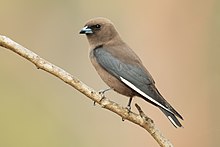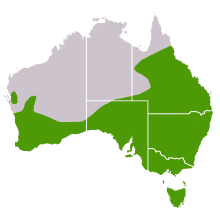Dusky woodswallow
| Dusky woodswallow | |
|---|---|

| |
| Scientific classification | |
| Domain: | Eukaryota |
| Kingdom: | Animalia |
| Phylum: | Chordata |
| Class: | Aves |
| Order: | Passeriformes |
| Family: | Artamidae |
| Genus: | Artamus |
| Species: | A. cyanopterus
|
| Binomial name | |
| Artamus cyanopterus (Latham, 1801)
| |

| |
The dusky woodswallow (Artamus cyanopterus) The global
The name "woodswallow" is a misnomer as they are not closely related to true swallows. Instead, they belong to the family Artamidae, which also includes butcherbirds, currawongs and the Australian magpie.
Taxonomy
The dusky woodswallow was first described by the English ornithologist
Description
The dusky woodswallow is medium-sized and swallow-like,[citation needed] with a dark brown hue,[4] but there have been instances where the bird has appeared grey.[5] The birds have a black patch in front of the eyes,[citation needed] and grey (sometimes also black)[citation needed] wings with white streaks on them.[4][5][citation needed] The dusky woodswallow has a black, white-tipped tail[4][5][citation needed] with a silver underwing.[citation needed] The birds have a blue-grey bill capped with black.[4][5] Dusky woodswallows are known to spontaneously 'wag' or swivel their tails fervently, a trait which is common among many other species of woodswallow.[5]
Relations to other woodswallows
In a significant difference from other woodswallows, dusky woodswallows have a distinctive white patch on the outer wing. Dusky woodswallows also seem to typically be more smoky brown than other species of woodswallow.[5] The little woodswallow, a smaller, darker woodswallow is also slightly more smoky brown that other woodswallows, but that is the only similarity that the latter has with the dusky woodswallow; the little woodswallow does not share a white patch on the outer wing.[5]
Distribution and habitat

The birds live primarily in open eucalyptus forests and woodlands.[citation needed] They range mostly from Atherton Tableland, Queensland, down to Tasmania and west to Eyre Peninsula, in South Australia.[4] They roost communally, usually nocturnally. During the breeding season, they nest in large flocks to make sure to keep predators away from young.[4] These flocks can be 20–30 dusky woodswallows in size.[9]
Dusky woodswallows adhere to seasonal migration and movements. The birds are a nomadic species, and tend to move quite spontaneously.[4] However, one certain change of habitat occurs for the south-eastern birds, who migrate northward for Autumn.[4]
Communally roosting birds, the dusky woodswallow has a variety of chattering calls which are used in certain situations. The most distinctive of these calls is perhaps the one which is used when a predator or intruder approaches, which consists of a harsh mobbing call to warn others.[citation needed]
Behaviour
Feeding and diet

The diet of the bird can be varied. They eat various forms of foliage and other grassy material that they find on the ground on in trees and shrubs. Dusky woodswallows have been seen eating termites, butterflies and other insects. They also eat nectar from flowers.[4][5] One notable aspect of their feeding habits is the way they hunt flying insects, which is done by picking them up on their wing.[5] They do, however, also eat their prey from the ground, and they often find inconspicuous places to perch while waiting for prey, such as utility lines and the like.[4] They have also been observed engaging in kleptoparasitism, working as a group to rob a restless flycatcher of its prey.[10]
Breeding
The nest of the dusky woodswallow consists of twigs,
Conservation status
The dusky woodswallow has a very large range.
See also
- List of Australian birds
References
- ^
- ISBN 978-0-511-21161-4
- ISBN 0643067051
- ^ a b c d e f g h i j k l m "Dusky Woodswallow Artamus cyanopterus". ArthurGrosset.com. February 2006. Retrieved 2007-08-31.
- ^ a b c d e f g h i j k "Bird Finder:Dusky Woodswallow". BirdsinBackyards.net. Archived from the original on 2008-04-30. Retrieved 2007-08-31.
- ^ Taylor, Robin (1999) Wild Places of Greater Melbourne
- ^ Latham, John (1801). Supplementum indicis ornithologici sive systematis ornithologiae (in Latin). London: Leigh & Sotheby. p. xlvi.
- ISBN 978-0-19-910207-5.
- ^ a b "Animal facts: Dusky Woodswallow". Featherdale Wildlife Park. Archived from the original on 2007-08-30. Retrieved 2007-08-31.
- .
Further reading
- del Hoyo, Josep, A. Elliott, J. Sargatal, J. Cabot, Handbook of the Birds of the World Barcelona: Lynx Edicions, 1992.
- Dickinson, Edward C., ed. The Howard and Moore Complete Checklist of the Birds of the World, 3rd edition Princeton, NJ and Oxford, U.K.: Princeton University Press, 2003.
- Forshaw, Joseph, ed. Encyclopedia of Birds, 2nd ed. San Diego, CA: Academic Press, 1998.
- Harrison, Colin James Oliver. Birds of the World London and New York: Dorling Kindersley, 1993.
- Perrins, Christopher M., and Alex L. A. Middleton, eds. The Encyclopedia of Birds. New York: Facts on File, 1985.

